-
Countries
-
Data and Analysis
-
Special Focus
-
Crisis Responses
Baseline Assessment
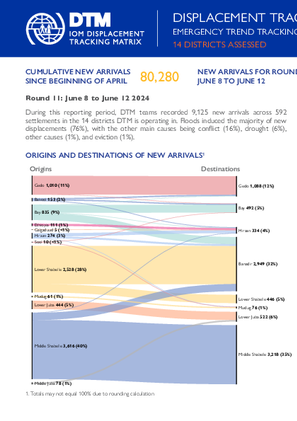
Contact
DTM Somalia, IOMSomaliaDTM@iom.int
Language
English
Location
Somalia
Period Covered
Jun 08 2024
Jun 12 2024
Activity
- Mobility Tracking
- Baseline Assessment
This latest round of Emergency Trends Tracking was initiated in April 2024 to monitor displacements movements during the Gu rainy season. Districts covered in this round include Afgooye, Afmadow, Baardheere, Baidoa, Balcad, Belet Weyne, Dayniile, Gaalkacyo, Hodan, Jamaame, Jowhar, Kahda, Kismaayo, Luuq. ETT is a crisis-based tool that tracks sudden displacement triggered by specific events or emerging crises.
The objective of ETT is to help prioritize humanitarian response and to enable partners to deliver rapid assistance. Based on previous shock induced displacement patterns, the humanitarian community expects that people will continue to move toward urban areas in search of humanitarian services. Consequently, the ETT coverage focuses on the main urban centers and surrounding villages for each assessed district. The data is collected through Key Informant Interviews (KIIs) at the location level, from Sunday to Wednesday every week. It includes information on new arrivals, numbers and demographic of IDPs, reasons for displacement, intentions, humanitarian assistance and priority needs among others.
The ETT tool also adapts to regional contexts: because of the very high number of IDP sites in Khada and Daynile districts in Banadir region and in Baidoa district in Bay region, a zonal approach has been adopted for these areas. Each week, KIIs are first conducted at the zone level to indicate to the field teams which locations have received the most new arrivals and which need to be assessed. To facilitate the joint analysis of the CCCM (Camp Coordination and Camp Management) Cluster’s New Arrivals Tracker (NAT) and ETT data, the assistance and needs indicators are identical in both tools.

Contact
IOMASTANA@iom.int
Language
English
Location
Kazakhstan
Period Covered
Jan 01 2024
Mar 31 2024
Activity
- Survey
- Flow Monitoring
- Mobility Tracking
- Baseline Assessment
The quarterly report is developed by combining secondary data obtained from different sources, including government agencies, international organizations, non-profit entities, and other types of organizations. More specifically, the report for the first quarter of 2024 was derived from data from the Ministry of Internal Affairs, Bureau of National Statistics, and Border Service of Kazakhstan. The data was compiled through a combination of published sources and direct requests to the partners and government agencies.
Contact
DTMSudan@iom.int
Location
Sudan
Activity
- Mobility Tracking
- Baseline Assessment
Period Covered
May 09 2024 -Jun 11 2024
- An estimated total of 10,095,054 IDPs were displaced across 8,239 locations, in 183 localities in all 18 states in Sudan.
- An estimated 7,262,187 individuals were displaced internally within Sudan since 15 April 2023.
- An estimated 26 per cent of IDPs who were initially displaced prior to the onset of current conflict experienced secondary displacement since 15 April 2023.
- Approximately 2,170,592 individuals crossed borders into neighbouring countries since 15 April 2023.
- The top states of origin among IDPs were Khartoum (36%), South Darfur (21%), and North Darfur (12%).
- The states hosting the most IDPs were South Darfur (18%), North Darfur (13%) and Central Darfur (9%).
- Over half (55%) of IDPs were reportedly children under the age of 18-years-old.
A more detailed version of this dataset is available, to get access kindly click on the 'Request Access' button
Population Groups
IDPs
Survey Methodology
Unit of Analysis Or Observation
Admin Area 2
Admin Area 3
Type of Survey or Assessment
Key Informant
Keywords
Geographical Scope
Administrative boundaries with available data
The current dataset covers the following administrative boundaries
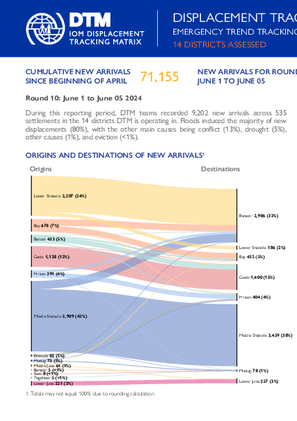
Contact
DTM Somalia, IOMSomaliaDTM@iom.int
Language
English
Location
Somalia
Period Covered
Jun 01 2024
Jun 05 2024
Activity
- Mobility Tracking
- Baseline Assessment
This latest round of Emergency Trends Tracking was initiated in April 2024 to monitor displacements movements during the Gu rainy season. Districts covered in this round include Afgooye, Afmadow, Baardheere, Baidoa, Balcad, Belet Weyne, Dayniile, Gaalkacyo, Hodan, Jamaame, Jowhar, Kahda, Kismaayo, Luuq.
ETT is a crisis-based tool that tracks sudden displacement triggered by specific events or emerging crises. The objective of ETT is to help prioritize humanitarian response and to enable partners to deliver rapid assistance. Based on previous shock induced displacement patterns, the humanitarian community expects that people will continue to move toward urban areas in search of humanitarian services. Consequently, the ETT coverage focuses on the main urban centers and surrounding villages for each assessed district. The data is collected through Key Informant Interviews (KIIs) at the location level, from Sunday to Wednesday every week. It includes information on new arrivals, numbers and demographic of IDPs, reasons for displacement, intentions, humanitarian assistance and priority needs among others.
The ETT tool also adapts to regional contexts: because of the very high number of IDP sites in Khada and Daynile districts in Banadir region and in Baidoa district in Bay region, a zonal approach has been adopted for these areas. Each week, KIIs are first conducted at the zone level to indicate to the field teams which locations have received the most new arrivals and which need to be assessed.
To facilitate the joint analysis of the CCCM (Camp Coordination and Camp Management) Cluster’s New Arrivals Tracker (NAT) and ETT data, the assistance and needs indicators are identical in both tools.
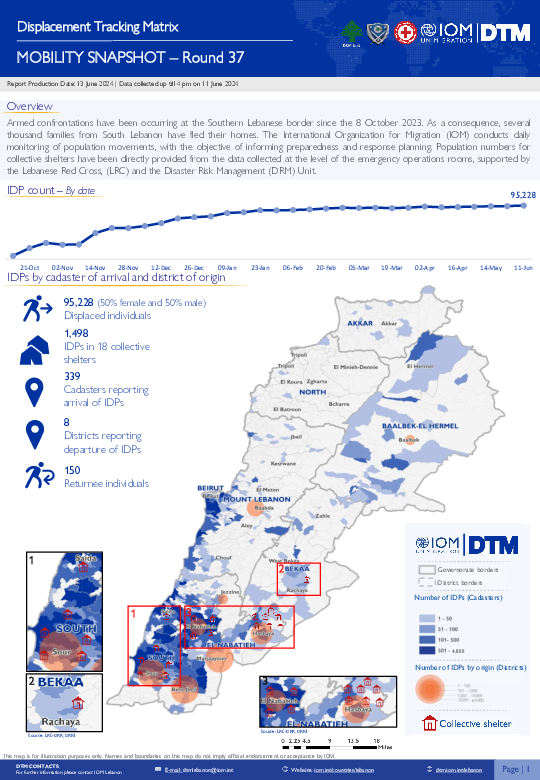
Contact
dtmlebanon@iom.int
Language
English
Location
Lebanon
Period Covered
Oct 10 2023
Jun 11 2024
Activity
- Mobility Tracking
- Baseline Assessment
Since October 8 there has been an increase in cross-border incidents between Israel and Lebanon, resulting in the displacement of people both within the South and elsewhere within the country. Since October 10, the Displacement Tracking Matrix (DTM) has been conducting the daily monitoring of population movements. The objective of the exercise is to inform preparedness and response planning.
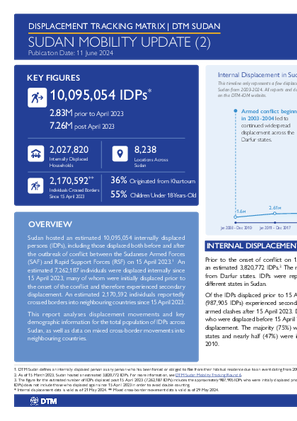
Contact
DTM Sudan; dtmsudan@iom.int
Language
English
Location
Sudan
Period Covered
Apr 15 2023
Jun 11 2024
Activity
- Mobility Tracking
- Baseline Assessment
This report reflects data corresponding to Sudan Mobility Update (2) dataset. The dataset is available here.
Overview:
This report provides an overview of the total population of internally displaced persons (IDPs) in Sudan, including those displaced both before and after the onset of conflict on 15 April 2023.
The displacement crisis in Sudan has been unfolding for over two decades, with roots in the Darfur conflict beginning in 2003. Prior to the onset of conflict on 15 April 2023, Sudan already hosted an estimated 3,820,772 IDPs. The majority (80%) reportedly originated from Darfur states, and most were initially displaced between 2003 and 2010. Of these IDPs, many experienced secondary displacement after 15 April 2023. Since 15 April 2023, an estimated 7,262,187 individuals were displaced internally within Sudan — including those who experienced secondary displacement.
When accounting for those displaced both before and after 15 April 2023, DTM estimated that Sudan hosted a total of 10,095,054 IDPs.
Key Findings:
- An estimated total of 10,095,054 IDPs were displaced across 8,239 locations, in 183 localities in all 18 states in Sudan.
- An estimated 7,262,187 individuals were displaced internally within Sudan since 15 April 2023.
- An estimated 26 per cent of IDPs who were initially displaced prior to the onset of current conflict experienced secondary displacement since 15 April 2023.
- Approximately 2,170,592 individuals crossed borders into neighbouring countries since 15 April 2023.
- The top states of origin among IDPs were Khartoum (36%), South Darfur (21%), and North Darfur (12%).
- The states hosting the most IDPs were South Darfur (18%), North Darfur (13%) and Central Darfur (9%).
- Over half (55%) of IDPs were reportedly children under the age of 18-years-old.
Note: The number of IDPs displaced post 15 April 2023 (7,262,187 IDPs) includes the estimated 987,905 IDPs who were initially displaced prior to 15 April 2023 and experienced secondary displacement since 15 April 2023. DTM Sudan defines an internally displaced person as any person who has been forced or obliged to flee from their habitual residence due to an event dating from 2003 onwards.
Contact
dtmlebanon@iom.int
Location
Lebanon
Activity
- Mobility Tracking
- Baseline Assessment
Period Covered
Oct 10 2023 -May 28 2024
Since October 8 there has been an increase in cross-border incidents between Israel and Lebanon, resulting in the displacement of people both within the South and elsewhere within the country. Since October 10, the Displacement Tracking Matrix (DTM) has been conducting the daily monitoring of population movements. The objective of the exercise is to inform preparedness and response planning.
Aggregated data is available through the DTM API: https://dtm.iom.int/data-and-analysis/dtm-api
A more detailed version of this dataset is available, to get access kindly click on the 'Request Access' button
Population Groups
IDPs
Returnee (Previously Internally Displaced)
Survey Methodology
Unit of Analysis Or Observation
Admin Area 2
Admin Area 3
Household
Individual
Type of Survey or Assessment
Key Informant
Keywords
Geographical Scope Full Coverage
Administrative boundaries with available data
The current dataset covers the following administrative boundaries
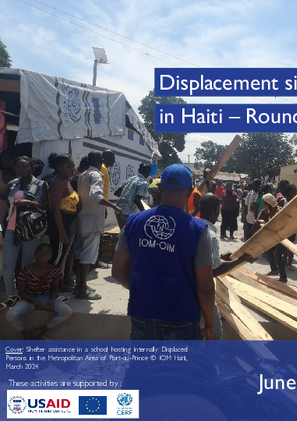
Contact
DTM Haiti, dtmhaiti@iom.int
Language
English
Location
Haiti
Period Covered
Apr 24 2024
May 31 2024
Activity
- Mobility Tracking
- Baseline Assessment
- Site Assessment
- Village Assessment
The Round 6, published in early March 2024, indicated that 362,551 people were
internally displaced in Haiti. This new Round indicates the presence of 578,074 internally displaced people, almost 60%
more than in Round 6. This increase is due to the deterioration of the security situation observed in the MAPAP, Haiti’s
capital, between the end of February and April 2024 in particular. The increase in the number of IDPs was more
identified in provinces where it increased by 95% (compared to 15% in the MAPAP). Indeed, following the increase in
violence in the MAPAP, many people fled the capital to seek refuge in provinces.
The Great South was the region that saw the largest increase in the number of IDPs hosted there (130% more
compared to Round 6). Nearly half (47%) of IDPs in the country are located in the Great South.
The majority of IDPs in the country are hosted in provinces: 68% in provinces vs. 32% in the MAPAP
The IDPs in provinces are mainly people who fled the MAPAP: 78% of IDPs in provinces came from the MAPAP.
Artibonite, where half of the IDPs fled areas located in this department, is an exception. In all other departments of the
country, IDPs mainly came from the MAPAP.
At the national level, the majority of IDPs are hosted by host families: 80% vs 20% in sites. However, in the MAPAP,
the majority of IDPs reside in sites (61% in sites vs 39% in host families), while in provinces the opposite is true (97% in
host families vs 3% in sites). It is crucial to support host communities in provinces, particularly in the Great South, to
enable them to continue hosting IDPs; and it is important to promote social cohesion between these two population
groups. Without the resilience of host communities, the number of sites in provinces is likely to increase as has been the
case in the MAPAP. Indeed, at the beginning of the crisis, the majority of IDPs in the MAPAP were hosted by host
families: only about 2 out of 10 IDPs were in sites in 2022; this figure increased to 6 out of 10 IDPs in 2023. One of the
main reasons for this increase was the lack of resources of host communities to continue hosting IDPs and the
deterioration of social cohesion in this context.
In addition, 50,000 returnees formerly IDPs were identified, particularly in the MAPAP, in Croix-des-Bouquets (21%),
Cité Soleil (14%), Port-au-Prince (12%); in the South in Tiburon (19%); and in the Center in Sauts d’Eau (10%). It should
be noted that for the moment these returns remain very fragile and are not sustainable, particularly in the MAPAP.
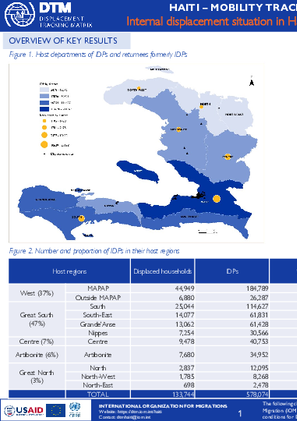
Contact
DTM Haiti, dtmhaiti@iom.int
Language
English
Location
Haiti
Period Covered
Feb 24 2024
May 31 2024
Activity
- Mobility Tracking
- Baseline Assessment
- Site Assessment
- Village Assessment
The Round 6, published in early March 2024, indicated that 362,551 people were
internally displaced in Haiti. This new Round indicates the presence of 578,074 internally displaced people, almost 60%
more than in Round 6. This increase is due to the deterioration of the security situation observed in the MAPAP, Haiti’s
capital, between the end of February and April 2024 in particular. The increase in the number of IDPs was more
identified in provinces where it increased by 95% (compared to 15% in the MAPAP). Indeed, following the increase in
violence in the MAPAP, many people fled the capital to seek refuge in provinces.
The Great South was the region that saw the largest increase in the number of IDPs hosted there (130% more
compared to Round 6). Nearly half (47%) of IDPs in the country are located in the Great South.
The majority of IDPs in the country are hosted in provinces: 68% in provinces vs. 32% in the MAPAP
The IDPs in provinces are mainly people who fled the MAPAP: 78% of IDPs in provinces came from the MAPAP.
Artibonite, where half of the IDPs fled areas located in this department, is an exception. In all other departments of the
country, IDPs mainly came from the MAPAP.
At the national level, the majority of IDPs are hosted by host families: 80% vs 20% in sites. However, in the MAPAP,
the majority of IDPs reside in sites (61% in sites vs 39% in host families), while in provinces the opposite is true (97% in
host families vs 3% in sites). It is crucial to support host communities in provinces, particularly in the Great South, to
enable them to continue hosting IDPs; and it is important to promote social cohesion between these two population
groups. Without the resilience of host communities, the number of sites in provinces is likely to increase as has been the
case in the MAPAP. Indeed, at the beginning of the crisis, the majority of IDPs in the MAPAP were hosted by host
families: only about 2 out of 10 IDPs were in sites in 2022; this figure increased to 6 out of 10 IDPs in 2023. One of the
main reasons for this increase was the lack of resources of host communities to continue hosting IDPs and the
deterioration of social cohesion in this context.
In addition, 50,000 returnees formerly IDPs were identified, particularly in the MAPAP, in Croix-des-Bouquets (21%),
Cité Soleil (14%), Port-au-Prince (12%); in the South in Tiburon (19%); and in the Center in Sauts d’Eau (10%). It should
be noted that for the moment these returns remain very fragile and are not sustainable, particularly in the MAPAP.
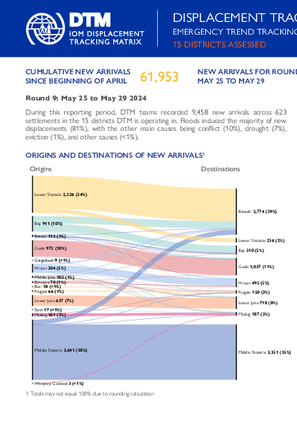
Contact
DTM Somalia, IOMSomaliaDTM@iom.int
Language
English
Location
Somalia
Period Covered
May 25 2024
May 29 2024
Activity
- Mobility Tracking
- Baseline Assessment
This latest round of Emergency Trends Tracking was initiated in April 2024 to monitor displacements movements during the Gu rainy season. Districts covered in this round include Afgooye, Afmadow, Baardheere, Baidoa, Balcad, Belet Weyne, Dayniile, Gaalkacyo, Garoowe, Hodan, Jamaame, Jowhar, Kahda, Kismaayo, Luuq.
ETT is a crisis-based tool that tracks sudden displacement triggered by specific events or emerging crises. The objective of ETT is to help prioritize humanitarian response and to enable partners to deliver rapid assistance. Based on previous shock induced displacement patterns, the humanitarian community expects that people will continue to move toward urban areas in search of humanitarian services. Consequently, the ETT coverage focuses on the main urban centers and surrounding villages for each assessed district. The data is collected through Key Informant Interviews (KIIs) at the location level, from Sunday to Wednesday every week. It includes information on new arrivals, numbers and demographic of IDPs, reasons for displacement, intentions, humanitarian assistance and priority needs among others.
The ETT tool also adapts to regional contexts: because of the very high number of IDP sites in Khada and Daynile districts in Banadir region and in Baidoa district in Bay region, a zonal approach has been adopted for these areas. Each week, KIIs are first conducted at the zone level to indicate to the field teams which locations have received the most new arrivals and which need to be assessed. To facilitate the joint analysis of the CCCM (Camp Coordination and Camp Management) Cluster’s New Arrivals Tracker (NAT) and ETT data, the assistance and needs indicators are identical in both tools.
Pagination
- Previous page
- Page 25
- Next page
